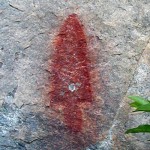It is early on a Catskill spring morning. I’m in the woods, looking down, trying to decipher a brown mushroom from the brown tangle of the forest floor.
The man with me, my foraging mentor, my Virgil—call him Toad—has taken an intense dislike of me.
“Do you see it?” he wants to know.
“Not yet.”
“There.” He jabs at a spot about three feet away. “Right there.”
I stare hard, offer up a little prayer. Still, nothing. Our quarry has eluded me yet again. No use fibbing a casual “Yes, yes, there we are.”
He will make me show him.
There is an uncomfortable silence.
“Christ,” mutters Toad. I figure he is going to take a swing at me.
I don’t remember why I wanted to learn how to forage for the wild foods of spring. Fiddleheads are okay, but I like the idea more than the grassy reality. Ramps are great, but I know how to identify them. And though I dearly love the peppery assault of wild watercress, I am disturbed by the thought of it being bathed in giardia. It must have been the mushrooms.
I knew enough not to go lightly into the forage patch. There was no need to die at the altar of wild things so as to commune with them on a higher level. First I had to learn how to identify them. The false morel didn’t get its name for nothing: “Scientists have found that the Conifer False Morel develops a compound similar to one used in the manufacture of rocket fuel,” snickers the Audubon field guide.
A fellow in the Catskills was recommended. Foraging ran in his blood, I was told; he knew fiddleheads by species when they were only two inches tall, could distinguish between a ramp and a lily-of-the-valley at forty paces. The mushroom hadn’t been invented that could elude his fungal radar. Toad. I gave him a call. As it had been a mild spring, we agreed to meet the last week of April on the upper Neversink.
Toad bends over and slices off the morel at the stalk. I hardly need volunteer that the mushroom remained invisible to me until he had it in his hand. He holds it up for me to admire. I murmur something about the ribs and pits being Nature’s gravy boat. Toad looks at me with a mixture of pity and contempt. He juts his chin at a neighboring valley, our next venue. He sheaths, I’m happy to note, his buck knife.
Morels can be hunted when the lilacs begin to open. They are one of those mushrooms taught to aspiring foragers, like hen of the woods and chicken of the woods and puffballs and the teeth, because they are identifiable, widespread, and choice. Jane Grigson recommends that you soak wild specimens in salted water to surprise any ants or other creatures lurking in the honeycomb. My cook wife, for no reason other than intuition, would rather give the mushrooms a good flick with the finger than immerse them.
The Catskill mushrooms being too furtive by half, my insecurities rise geometrically. I have a need to please Toad, to prove I’m no chump in the woods. Indeed, I like to think of myself a forest intimate, a latter-day waldgrave. I’ve had experiences—ecstasies—in the woods: I have spoken to trees, and they have answered; I have “run nood in the farst,” though less said about that the better. Greek olive groves are my familiars, as are Connecticut old growths, pistachio orchards along the Caspian, relic stands in northern Scotland, the apple forests of Tian Shan, the maple-birch-oak community around my house. I say this not to establish bragging rights, though that’s always important, but because I didn’t say it to Toad. Which is probably my smartest act of the day, or my second luckiest. It wouldn’t matter anyway. I am on his turf—here, now–and I look bad.
I turn my attention to more conspicuous quarry. The fiddleheads yodel. I whip out my Opinel–heavily burnished with use, a symbol of practical knowledge I flourish—and cut a few. I’m considering popping them directly into my mouth, for the brio and dash of it, when Toad comes up. “Bracken,” he says, wearily. “Cancerous. You want to stick to the ostrich and wood ferns. Let’s us stick to morels.”
We silently top a rise and silently descend along a wooded ridge to what looks like an abandoned orchard, out in the middle of nowhere. Nowhere and somewhere change with avidity in the Catskills.
Toad stops. Glowers. “Do you see them now?” Somewhere, an angel sings.
“Ah ha! There we are.” A morel sits nestled among fallen leaves. Then another and another, every one of them transparent in their guilt, like crows sidling away from a shredded bag of trash: “Who, me?” My revenge is quick and simple and involves a knife.
Toad slaps me on the back, a gesture at once comradely and barely contained in its violence. Did I hear “pathetic” escape from under his breath? I let it pass, lost to the glory of the moment.
(from Simple Cooking, reprinted in Some Delights from the Hudson Valley, edited by Danny Shanahan)
